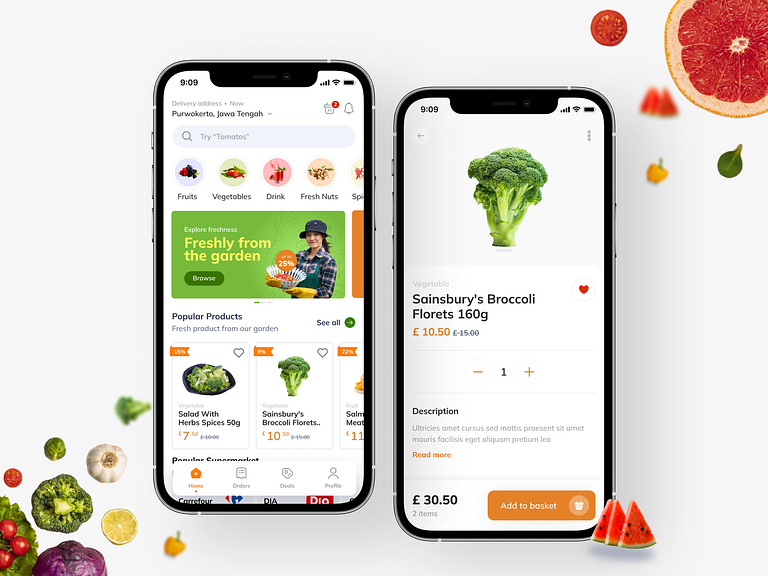In the rapidly evolving world of eCommerce, hyperlocal grocery marketplaces have emerged as a key trend. These platforms allow customers to order groceries online from local stores and receive deliveries quickly, often within hours. Building a hyperlocal grocery marketplace involves more than just setting up a website; it requires an in-depth understanding of logistics, user experience, and local community dynamics.
This guide will walk you through the steps to build an online hyperlocal grocery marketplace platform, including key considerations for technology, logistics, and marketing.
1. Understanding the Hyperlocal Concept
Hyperlocal refers to the idea of focusing on a geographically small area, typically a neighborhood or community, to offer services. In the context of grocery marketplaces, this means catering to consumers within a defined radius by connecting them with nearby grocery stores. These platforms aim to reduce delivery times and promote the consumption of local produce.
A hyperlocal model can be a win-win for local businesses and consumers. It helps small stores expand their reach, while customers benefit from quick delivery and access to a wider range of products from their community.
2. Identifying Market Demand
Before investing in building a hyperlocal grocery marketplace, you need to understand the market demand in your area. Ask yourself these questions:
- Are there many local grocery stores looking for a platform to increase their online visibility?
- Is there a customer base willing to use an online service for fast, local grocery delivery?
Market research is key to answering these questions. Conduct surveys, focus groups, and analyze competitors to assess the demand and potential gaps in the market. Identifying a niche, such as organic produce or specialty items, could give your platform a competitive edge.
3. Defining Your Business Model
Once you understand the market demand, the next step is to define your business model. There are a few different models you can consider for a hyperlocal grocery marketplace:
- Commission-based: The platform takes a percentage of each transaction between the customer and the store.
- Subscription-based: Stores pay a recurring fee to list their products on your marketplace.
- Delivery fee-based: Customers pay a delivery fee, which can either be a flat rate or dynamic based on the distance between the store and the customer.
Each model has its pros and cons. For example, the commission-based model is scalable, but it may discourage smaller businesses with lower margins. On the other hand, subscription-based models provide predictable revenue, but they require a larger base of partner stores.
4. Choosing the Right Technology
The technology stack you select for your platform will play a crucial role in its success. Your grocery marketplace needs to offer a seamless experience for both store owners and customers. Here are the essential components of a hyperlocal marketplace:
a) Marketplace Platform
You’ll need a robust eCommerce platform to list products, manage orders, and facilitate transactions. Popular solutions include Magento, Shopify, and custom-built platforms. Make sure your platform is mobile-friendly, as many users will be accessing it through their smartphones.
b) Location-Based Services
Since you’re operating on a hyperlocal level, integrating location-based services (LBS) is crucial. This allows the platform to show customers which stores are available in their area and provide accurate delivery estimates. Google Maps API or similar services can help with geolocation integration.
c) Real-Time Inventory Management
To provide a smooth customer experience, your platform needs to offer real-time inventory management. This ensures that the products listed on the site are always available for purchase, preventing out-of-stock items from being sold.
d) Payment Gateway
Choose a secure and reliable payment gateway to process transactions. Popular options include Stripe, PayPal, and Square. Ensure that your platform supports various payment methods, including credit/debit cards and digital wallets.
e) Delivery Management System
A core feature of your hyperlocal platform will be the delivery management system. This should include real-time tracking, route optimization, and driver assignment. You may want to partner with third-party logistics providers to ensure timely deliveries.
5. Building Partnerships with Local Stores
Your platform’s success largely depends on the strength of your partnerships with local grocery stores. You need to create a value proposition that appeals to them. Here’s how:
- Offer better visibility: Make it easy for stores to showcase their products online and reach a wider audience.
- Increase sales: Emphasize that joining your platform can boost their sales by attracting customers who prefer online shopping.
- Simple onboarding process: Ensure that the process for listing products and managing orders is straightforward.
Consider offering early adopters incentives such as reduced commissions or marketing support. Building a solid network of local stores from the start will give your platform a competitive edge.
6. Focusing on Logistics and Delivery
Logistics is at the heart of a hyperlocal grocery marketplace. Ensuring fast and efficient deliveries is what sets hyperlocal platforms apart from traditional grocery delivery services. Here are some key considerations:
a) Delivery Speed
The promise of quick delivery is a significant selling point for hyperlocal grocery platforms. Offering same-day or within-hours delivery can be a huge advantage.
b) Partnering with Local Delivery Services
If managing deliveries internally is too complex or expensive, you can partner with local delivery services or gig-economy workers. This allows for scalability without the need for a large in-house delivery team.
c) Optimizing Delivery Routes
To minimize delivery times and costs, use route optimization software. This ensures that delivery drivers take the most efficient routes, reducing fuel costs and delivery times.
7. Creating a User-Friendly App
Your marketplace’s app should be intuitive and user-friendly for both customers and grocery store owners. The app must include essential features such as:
- Search functionality: Allow users to search by product or store.
- Order tracking: Give customers real-time updates on their delivery status.
- Push notifications: Remind users of promotions, delivery updates, and restocked items.
The easier it is for users to navigate and place orders, the more likely they are to return to your platform.
8. Marketing and Customer Acquisition
Once your platform is built, the next step is to attract customers. Focus on hyperlocal marketing strategies to target users in your specific geographic area. Here are some tactics:
- SEO: Optimize your website and app for local search queries such as “grocery delivery near me.”
- Social media advertising: Use targeted ads on platforms like Facebook and Instagram to reach users in your area.
- Partnerships with local influencers: Collaborate with local influencers to promote your platform and increase brand awareness.
Loyalty programs and referral incentives can also help attract and retain customers.
9. Managing Customer Support
Providing excellent customer service is vital for retaining customers and ensuring their satisfaction. Your platform should offer easy access to support, whether through live chat, phone, or email. An FAQ section can also help users resolve common issues on their own.
Consider using AI-powered chatbots for instant responses to simple queries, freeing up your support team for more complex issues.
10. Legal and Compliance Considerations
Running a hyperlocal grocery marketplace involves several legal and regulatory aspects:
- Business licenses: Ensure that both your platform and participating stores comply with local business laws.
- Food safety regulations: Be aware of food safety standards in your region and ensure that the stores meet these requirements.
- Data protection: Your platform will handle sensitive customer information, so you must comply with data protection laws such as GDPR or CCPA.
Having legal counsel to navigate these regulations will help protect your business and build trust with customers and store owners.
Conclusion
Building an online hyperlocal grocery marketplace platform requires careful planning, strong partnerships, and a focus on logistics and technology. By understanding market demand, creating a user-friendly app, optimizing delivery logistics, and implementing targeted marketing strategies, you can create a platform that benefits both local stores and customers. As this market continues to grow, a well-executed hyperlocal grocery platform has the potential to become a key player in your community’s eCommerce ecosystem.
By following the steps outlined in this guide, you’re well on your way to creating a successful hyperlocal grocery marketplace that meets the needs of both businesses and consumers.
Also Read: Launch Your Online Grocery Platform



